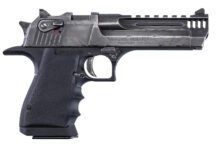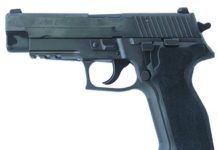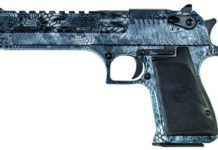New 380 ACP pistols are probably responsible for the ammunition shortage in 380 ACP — our friends at the gun shops tell us that these pistols are selling fast, and with every sale, customers purchase two to four boxes of ammunition. This time, we look at the breakthrough design of the Taurus Curve, so named because its handle is made to curve and conform to the body, as long as you are right handed. Ruger has offered a number of limited editions of the LCP in the past, but for the most part, they were simply a different finish or displayed some type of logo. The new LCP Custom pistol, however, features a vastly improved trigger similar to the RTK Sweet Pea triggers many of us added to the original LCP, and the design is considerably different as well.
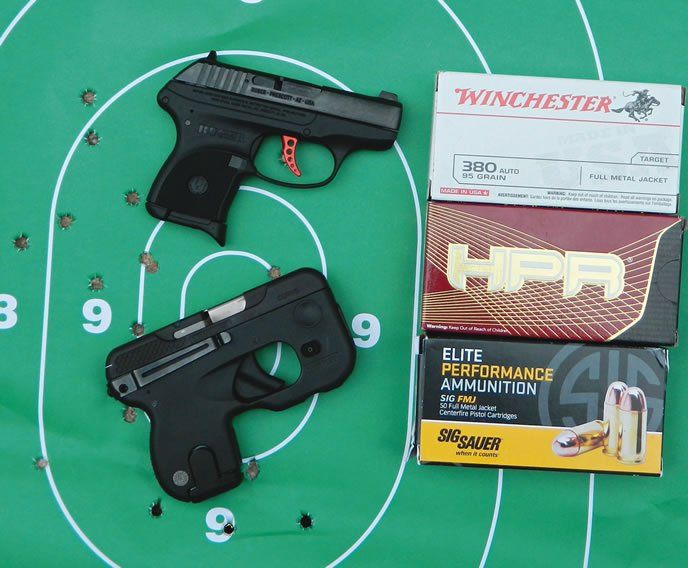
How We Tested
Our test ammunition included were three different weights and two bullet styles: HPR’s 90-grain cartridge, which pushes a Hornady XTP jacketed hollow point; the well-known Winchester USA 95-grain full metal jacket Q4206; and SIG Sauer’s Elite Performance load with full-metal-jacket 100-grain bullets. We fired the HPR 90-grain JHP ammunition to confirm feed reliability with a JHP bullet, and to our surprise, the HPR was the most accurate round tested. It is also worth mentioning that previous testing of 380 ACP loads lead us to believe that FMJs might be the best choice for these pocket pistols to ensure enough penetration (“Gauging 380 ACP Loads: FMJ May Be the Only Way to Go,” October 2010).
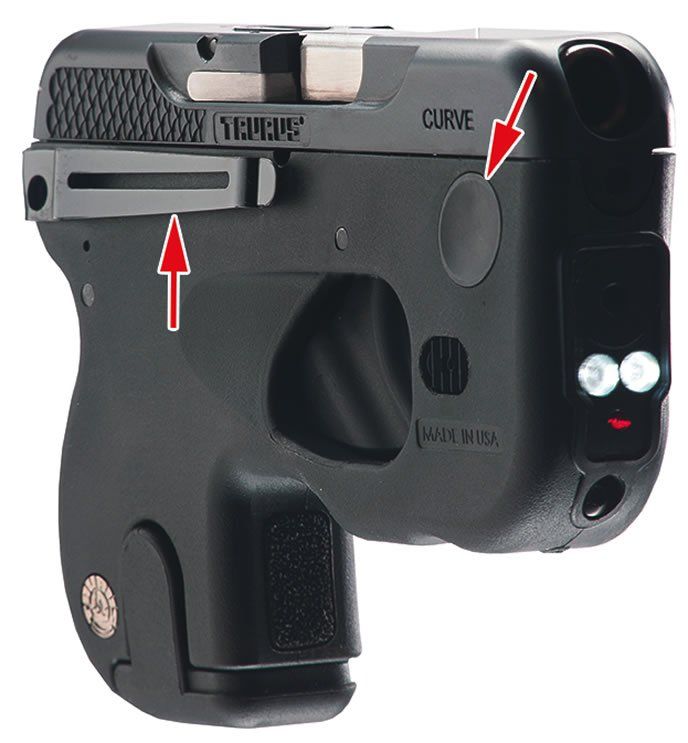
Normally, we test-fire pistols at 25 yards for service pistols and 15 yards for compacts. Here, we were forced to fire at 21 feet to give the Taurus Curve some semblance of a chance. The Taurus would have been hopeless at 15 yards, in our opinion. We found out about the Curve’s accuracy problems early. During dry firing at compact-pistol distance, we didn’t like the crosshairs on the rear of the Curve’s slide used for aiming. So after disassembling and lubricating each pistol, we began the firing portion of the test by loading each gun’s magazine with the SIG Sauer Elite Performance 100-grain full-metal-jacket loads and addressing a man-sized silhouette target from Birchwood Casey at 21 feet. At 21 feet, we still found the Curve to be pretty hopeless, so we moved to 14 feet to get the measure of the sights. We found ourselves firing too slowly while attempting to form some sort of sight picture. Finally, moving into some type of rhythm we managed to make 4- to 6-inch groups on the paper; however, repeatability was poor. At 21 feet, we could make 5- to 7-inch groups. Once we stopped firing and loaded another magazine, the next group on the same point of aim was often 2 inches to the left or right. All shooters fired the Curve to the right, 4 inches from the center of the paper. In contrast, at 21 feet the Ruger easily delivered 2-inch 5-shot groups or less with the three types of ammunition.
With each handgun, we also fired combat style as quickly as possible, but still paying attention to the sights. The LCP Custom pistol was accurate enough to keep the shots in the X-ring. We experienced a failure to go into battery during the first magazine of ammunition. Checking the lube again and paying attention to the grip, we experienced a second malfunction with the second magazine load. After these two initial break-in malfunctions, the pistol never repeated this problem. The Taurus did not experience a break-in malfunction, but it did suffer from a defective magazine, which we detail in the text below.
After firing a full box of Elite ammunition, we continued with Winchester FMJ loads, putting 50 rounds through each handgun without a problem. This time, we fired for accuracy and attempted to take hostage-rescue-type shots at 21 feet. With concentration from the shooter, the Ruger was capable of delivering saucer-sized accuracy, although this isn’t something we would like to rely on with this lightweight handgun. We did pull a few shots off with it, which wouldn’t have been good for the hostage or a bystander. Following are more detailed criticisms of both the Curve and the LCP Custom:
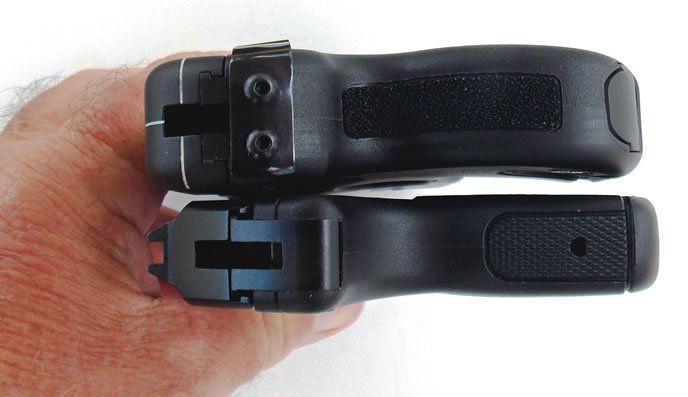
Taurus Curve 180CRVL #1-180031L 380 ACP, $380
This was our price at the time of the test from GanderMountain.com. MSRP is $392.42. The pistol was introduced in late 2014 and became available in early 2015. At launch, the company said the pistol was “The world’s first and only curved firearm engineered to fit the unique contours of your body. Taurus Curve is one ultra-comfortable, ultra-reliable personal defense handgun.” And this: “Your body has curves, so why aren’t pistols shaped to match? That’s precisely the question our engineering team challenged themselves to answer — and the results are unlike anything you’ve seen before… An extreme departure from your typical compact 380, you’ll find the Curve takes form and function to an entirely unprecedented level. With its patented, snag-free design, the Curve boasts the industry’s first-ever light and laser built right into the frame. Exceptionally accurate and extremely lightweight at just 10.2 ounces, the Curve is one ultra-comfortable, ultra-reliable personal defense handgun.”
There are some assertions in that statement we’ll take issue with in a moment. Our initial handling of the Curve showed that its removable pocket clip allowed carry in the pants with a certain degree of security — a step above simply slipping the piece in the waistband. In our view, the carrier would need a holster for IWB or pocket carry, but the Curve is a good stab at holster-less carry.
Out of its box, we noticed the pistol isn’t curved as much as the left side featured a concave surface. All the edges were knocked off, rounded, and smoothed for comfortable carry. The pistol didn’t have sights, which we discussed briefly above and more below, and there was no slide-stop control. The magazines featured a locking tab that held the magazine in the pistol. The slide locked open on the last shot, and the magazine is removed to lower the slide.
As we noted, the pistol had a geometric design on the rear of the slide to aid in aiming. There was also an integral laser and light combination. The rear crossbars were marked at the intersection of the bore, it is claimed. The Curve, like the Ruger, featured a loaded-chamber indicator. The pistol was supplied with what is actually a trigger cover, which may have some utility in pocket carry. But we advise being careful with this cover — it is too easy to move your hand into the vicinity of the bore with this set-up. Be certain to pull the cover down when removing it, and to come from the bottom and press up when returning it to position — and never let the hand wander near the barrel. The pistol was supplied with the trigger cover and two magazines, so this outranked the Ruger’s single magazine and cloth carrying case.
Using an index of superimposing the slide of the pistol over the target, we were able to make reasonably good hits at 5 yards. At 7 yards, the groups were widely spaced, perhaps 6 inches on average. When firing for accuracy at 21 feet, the Taurus delivered a 6-inch group off the bench in the hands of our best shot. We felt that this was a resounding accomplishment more attributable to muscle control than marksmanship. The groups were several inches off point of aim, and each group, fired at the same point of aim, was at least 3 inches from the other.
However, we had yet to consider the combination light and laser system incorporated into the Curve. The switch was on the right-hand side, as may be expected since this is a right-handed pistol. Press the switch forward, and the light and laser are activated. You may preset the switch for light or laser only. We feel that the best program is to set the switch for the default, both systems at once. When using the lights and laser around the house, in the dark, we found some utility in the design. The room was illuminated directly in front of the sights. Limited range testing showed that the laser was delivered with a close approximation to the point of aim and may be adjusted with tools supplied with the Taurus pistol. Did the light/laser combination change our mind about the pistol’s accuracy? No. For us, the pistol wasn’t useful past about 5 yards. The crosshair sights did not work for us, and we can’t recommend a product that has to be turned on to function. If the Curve had sights, the rating would be much different.
The Taurus Curve also had more malfunctions than the Ruger, and we traced them to a bad magazine latch on a magazine, not integral to the frame. This included the magazine falling free and several short cycles caused by the magazine slipping in the magazine well. Once we isolated the magazine causing the problems, the Taurus never suffered another malfunction. We shot most of the test with a single magazine. The pistol also featured a magazine disconnect, which meant the pistol will not fire without the magazine inserted. The consensus is that this isn’t ideal on a personal-defense pistol, but seems popular with makers these days.
Our Team Said: We were not enthralled with the Curve’s accuracy. We also think that while the pistol is designed to adhere to the curve of the body, this doesn’t help with pocket carry, and the Curve grip is both thicker and longer than the Ruger. As important, the Curve isn’t suited to left-handed shooters, in our estimation. Tactical trainers will point out that self-defense shooters should not be right or left handed, instead using a forward hand and a rear hand, depending upon the application and the threat. Even so, the Curve cannot be used well by a left-handed shooter, and the same goes for a right-handed shooter who tries to shoot it left-handed. A good point was the Curve’s trigger action. The let-off was a clean 5.5 pounds and consistent.
Ruger LCP-C Custom No. 3740 380 ACP, $419
MSRP is this price. Clicking the link on theGalleryofGuns.comGun Genie accessed from the Ruger site, we got several price quotes from dealers in the Houston area. The low was from 19Eleven Enterprises, with a walk-out price with fees and taxes, of $346.18. At Top Gun Range, walk-out price with fees and taxes was $404.79; Full Armor Firearms’ walk-out price was $414.55; and the walk-out price with fees and taxes from Collectors Firearms was $430.55.
We have tested several iterations of the LCP in the past. In the June 2008 issue, the inaugural version of the pistol graded an A-. In the July 2013 issue, the #3701 model ranked a B+, the same grade as a Ruger LCP-LM No. 3718 with laser earned five months earlier. The latest test was of a laser-equipped LCP-CT, fitted with a Crimson Trace red laser. It earned an A- grade. In the Custom version, the sights and trigger action are the primary improvements. Also, the new Ruger is a quarter-ounce heavier than the older version.
The trigger broke at a smooth 7.25 pounds with little take up and no creep or backlash. The sights were very effective. The new sights were raised higher on the slide than on previous guns, but more important, they offered a good sight picture. We saw the benefit during the firing test, as noted above. Sights are important on any handgun and may be even more important on a light pistol. After all, accuracy is critical, and what power the pistol has must be delivered accurately. As one of our raters pointed out, as a trainer he will never be the person to tell a judge he taught a student to fire the handgun without using the sights. The visible rear notch and front post of the Ruger are a big help in delivering accurate fire, we found. Although designed purely for personal defense, the Ruger is accurate enough to pop a rodent or reptile at a few yards, which is always an advantage.
The Ruger remains a compact package, with a length of 5.2 inches and a height of 3.8 inches, and it is only 0.8 inch thick. The frame was polymer. The recoil spring was tight, even stiff, but this is the price you have to pay for a small locked-breech pistol. The Taurus was just as stiff. The cocking serrations were well designed. The pistol uses a Browning-type magazine release and does not lock open on the last shot. The magazine held six rounds, and only one magazine was supplied with the pistol — it should come with a spare. Adding another costs $22.62.
Our Team Said: The Ruger was reliable after a couple of break-in malfunctions. We fired 195 rounds through it for record, 50 of each of the three loads and then 15 more of each load for accuracy, and our shooters never experienced a problem of any type after the initial break in. All in, the Ruger LCP-C Custom 380 ACP No. 3740 was more accurate than the Taurus and was better suited for use by the non-dominant or left hand.
Written and photographed by R.K. Campbell, using evaluations from Gun Tests team testers.

























